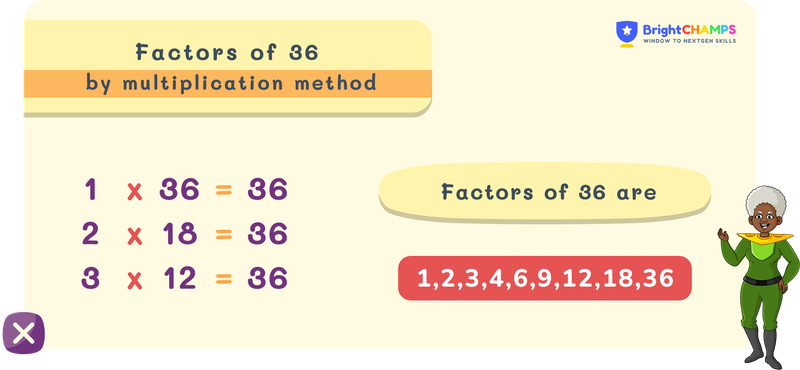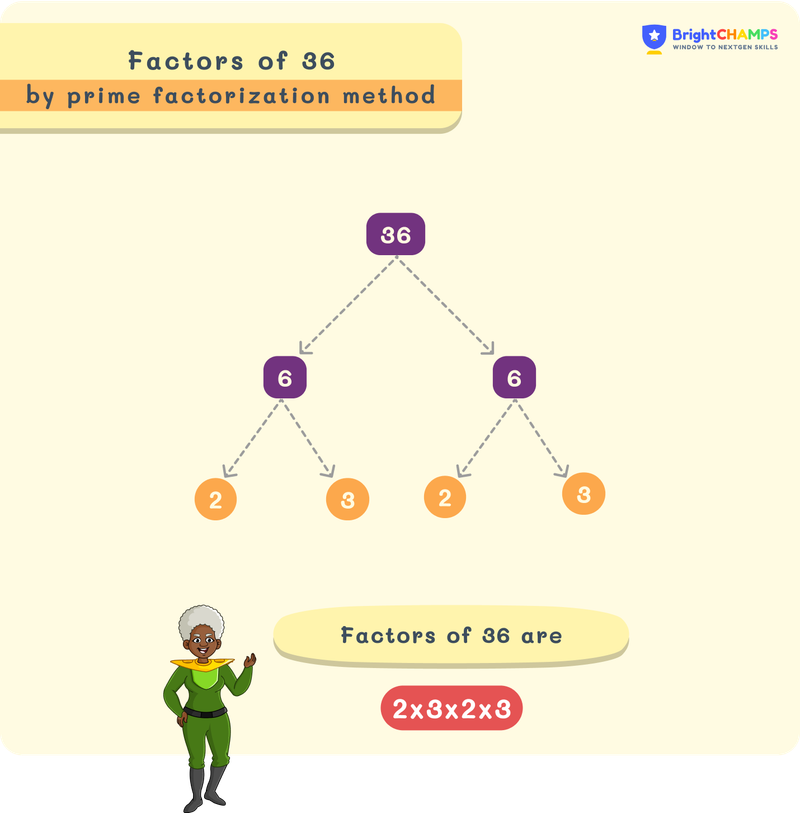
 653 Learners
653 LearnersLast updated on May 26th, 2025

Factors of 36

Factors are those numbers whose dividend is divisible by quotient completely. The factors of 36 are whole numbers.
What are the Factors of 36 ?
Factors of 36 will divide 36 completely. These are multiplied in pairs to get 36 as the product.
1, 2, 3, 4, 6, 9, 12, 18 and 36 the factors of 36.
Negative Factors: These are negative counterparts of the positive factors.
Negative factors: -1, -2, -3, -4, -6, -9, -12, -18 and -36
Prime Factors: Prime factors are the prime numbers when multiplied together, giving 36 as the product.
Prime factors: 2 and 3
Prime Factorization: Prime factorization involves breaking 36 into its prime factors.
It is expressed as 22 × 32
sum of the factors of 36 :The sum refers to the number we get by adding the factors of the given number.
Sum = 1+2 + 3 + 4 + 6 + 9 + 12 + 18 + 36 = 91
Table listing the factors of 36:
How to Find the Factors of 36?
There are different methods to find the factors of 36.
Methods to find the factors of 36:
- Multiplication Method
- Division Method
- Prime Factor and Prime Factorization
- Factor Tree
Finding Factors Using Multiplication Method
The multiplication method involves finding pairs of numbers that give 36 as the product. Steps are given below:
Step 1: Find the pair of numbers whose product is 36.
Step 2: The factors are those numbers, when multiplied, give 36.
Step 3: Make a list of numbers whose product will be 36
A list of numbers whose products are 36 is given below:
- 1 × 36 = 36
- 2 × 18 = 36
- 3 × 12 = 36
- 4 × 9 = 36
- 6 × 6 = 36

Finding Factors Using Division Method
The division method finds the numbers that fully divide the given number. Step-by-step process given below:
Step 1: Since every number is divisible by 1, both 1 and the number will always be its factors. Example: 36÷1 = 36
Step 2: Move to the next integer. Both divisor and quotient are the factors. Example: 36÷2 = 18, 36÷3 = 12 and so on. Here, 2 is the divisor and 18 is the quotient.

Prime Factors and Prime Factorization
Multiplying prime numbers to get the given number as their product is called prime factors. Prime factorization is the process of breaking down the number into its prime factors.
Prime Factors of 36: Number 36 has only two prime factors.
Prime factors of 36: 2, 3
Steps to find the prime factors of 36:
Step 1: Divide 36 with the smallest prime number 2
36÷2 = 18
18÷2 = 9
Step 2: Take the next prime number, which is 3
9÷3 = 3
3÷3 = 1
Prime Factorization of 36: Prime Factorization breaks down the prime factors of 36.
Expressed as 22 × 32
Factor Tree
The prime factorization is visually represented using the factor tree. It helps to understand the process easily.

Factor Pairs: Factors of 36 can be written in both positive pairs and negative pairs.
Positive Factor Pairs: (1, 36), (2, 18), (3,12), (4, 9), (6,6)
Negative Factor Pairs: (-1, -36), (-2, -18), (-3, -12), (-4, -9), (-6, -6)

Common Mistakes and How to Avoid Them in Factors of 36
Mistakes can occur while finding the factors. Learn about the common mistakes that can occur. Solutions to solve the common mistakes are given below.

Factors of 36,examples

Problem 1
Can 6 divide 36 equally?

Yes, it divides equally
Explanation
When 36 is divided by 6 you get zero as the remainder.

Problem 2
What is the smallest prime factor of 36?

2 is the smallest prime factor
Explanation
2 has two factors, 1 and the number itself.

Problem 3
Is 2 a multiple of 36?

No, 2 is not a multiple.
Explanation
Multiple is the number you get when multiplied by another number. Here, 2 is the factor of 36.

Problem 4
The sum of perfect square factors?

The sum is 50.
Explanation
1, 4, 9, and 36 are the perfect squares among the factors.
Add all the factors and the sum will be 50

Problem 5
Which factor pair gives zero when subtracted?

(6,6) give zero as the difference.
Explanation
Write down the factor pairs of 36
From the factor pairs, choose the pair whose difference is zero.


FAQs on Factors of 36
1.What is the highest factor of 36?
2.Highest prime factor of 36
3.How do you express the prime factorization of 36?
4.List the positive pairs of 36
5.Can there be negative factors of 36?
6.How can children in Bahrain use numbers in everyday life to understand Factors of 36?
7.What are some fun ways kids in Bahrain can practice Factors of 36 with numbers?
8.What role do numbers and Factors of 36 play in helping children in Bahrain develop problem-solving skills?
9.How can families in Bahrain create number-rich environments to improve Factors of 36 skills?
Important glossaries for the Factors of 36
- Factors:Factors are the numbers that divide the given number without any remainder.
- prime factorization:The prime factorization of numbers involves breaking the number into its prime factors.
- Prime factors: Prime factors are prime numbers whose product is equal to the given number.
- Composite numbers: Composite numbers are numbers having more than two factors.
Explore More numbers
![Important Math Links Icon]() Previous to Factors of 36
Previous to Factors of 36
![Important Math Links Icon]() Next to Factors of 36
Next to Factors of 36
About BrightChamps in Bahrain


Hiralee Lalitkumar Makwana
About the Author
Hiralee Lalitkumar Makwana has almost two years of teaching experience. She is a number ninja as she loves numbers. Her interest in numbers can be seen in the way she cracks math puzzles and hidden patterns.
Fun Fact
: She loves to read number jokes and games.




